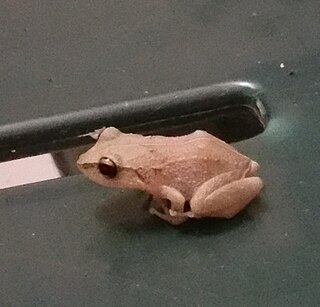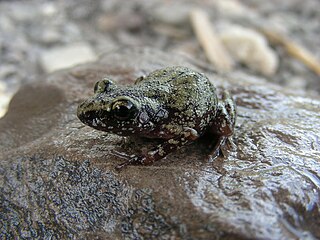Craugastor catalinae is a species of frogs in the family Craugastoridae. It is found in the Río Cotón drainage in the Pacific southwestern Costa Rica and on the Pacific slopes of Volcán Barú, western Panama. The specific name catalinae, rather obliquely, honors Karen R. Lips: Spanish name "Catalina" corresponds to Danish name "Karen". Lips collected a part of the type series and has "contributed substantially to our knowledge of the Río Cotón drainage herpetofauna and the declining amphibian populations problem in lower Central America."
Craugastor rhyacobatrachus is a species of frogs in the family Craugastoridae. It is found in the Pacific slopes of the Talamanca-Barú Massif of Costa Rica and western Panama. The specific name rhyacobatrachus is derived from Greek batrachos and rhyaco ("torrent"), in reference to the torrential streams that this species inhabits.
Pristimantis bearsei is a species of frog in the family Craugastoridae. It is endemic to Peru and only known from the region of its type locality northeast of Tarapoto in the San Martín Region. Common name Bearse's robber frog has been coined for this species.
The false green robber frog is a species of frogs in the family Eleutherodactylidae. It is endemic to the Massif de la Hotte, southwestern Haiti.
Eleutherodactylus corona is a species of frog in the family Eleutherodactylidae. It is endemic to the Massif de la Hotte, Haiti. The specific name corona is derived from the Latin word for "crown" and refers to the distinctive tubercles on the top of the head of these frogs. Common name Caye Paul robber frog has been coined for it.

Eleutherodactylus dilatus is a species of frog in the family Eleutherodactylidae. It is endemic to Mexico and restricted to the Chilpancingo region of the Sierra Madre del Sur in central Guerrero. Its common name is Guerreran peeping frog.
Pristimantis euphronides is a species of frog in the family Craugastoridae. It is endemic to Grenada, an island in the Lesser Antilles, the Caribbean. Is sometimes known as the Grenada frog. It was originally described as a subspecies of Eleutherodactylus urichi, but since 1994 it has been recognized as a full species.
The khaki bromeliad frog or Fowler's robber frog is a species of frog in the family Eleutherodactylidae endemic to Hispaniola. It occurs in the Massif de la Selle and is known from one site in the Dominican Republic and one in Haiti. It is named after Danny C. Fowler, collector of the holotype.
Eleutherodactylus glaphycompus is a species of frog in the family Eleutherodactylidae endemic to the Tiburon Peninsula, Haiti. Its common name is Southwest Haiti robber frog. The specific name glaphycompus refers to its microhabitat, fissures and crevices in limestone rock.
Eleutherodactylus gossei is a species of frog in the family Eleutherodactylidae. It is endemic to Jamaica where it is widespread. An introduced population existed in Bermuda but appears to have been extirpated. The specific name gossei honors Philip Henry Gosse, an English naturalist, missionary, and science writer. Its common names are Jamaican forest frog and Spaldings robber frog, the latter apparently after Spaldings, its type locality.
Eleutherodactylus lucioi is a species of frog in the family Eleutherodactylidae. It is endemic to Haiti, where it is only known from a single specimen collected near Môle-Saint-Nicolas in Nord-Ouest department.
Pristimantis maculosus is a species of frog in the family Craugastoridae. It is endemic to Colombia and is only known from few localities in the Cordillera Central in Caldas, Antioquia, and Quindío Departments. The specific name maculosus is Latin for "dappled" or "spotted" and refers to the pale spots on the hidden surfaces of this species. Common name spotted robber frog has been coined for it.
Eleutherodactylus parapelates is a species of frog in the family Eleutherodactylidae. It is endemic to the Massif de la Hotte in southwestern Haiti. Common names Casillon robber frog and Macaya burrowing frog have been proposed for it.

Eleutherodactylus pinchoni is a species of frog in the family Eleutherodactylidae. It is endemic to Guadeloupe and known from the Basse-Terre. Common name Grand Cafe robber frog has been coined for it.

Eleutherodactylus pipilans is a species of frog in the family Eleutherodactylidae. It is found in southern and southeastern Mexico and southwestern Guatemala.
Eleutherodactylus rhodesi is a species of frog in the family Eleutherodactylidae. It is endemic to Haiti, where it is only known from the area of its type locality on northeastern base of the Presqu'ile du Nord-Ouest, near Port-de-Paix, Nord-Ouest department.
Eleutherodactylus sciagraphus is a species of frog in the family Eleutherodactylidae. It is endemic to Haiti and only known from near its type locality at an elevation of 1,060–1,080 m (3,480–3,540 ft) asl in the Massif de la Hotte. Its specific name refers to its heavily barred hindlimbs. Its common name is Sud robber frog.
Pristimantis shrevei is a species of craugastorid frog that is endemic to Saint Vincent, the West Indies. Its common name is Saint Vincent frog.
Eleutherodactylus zugi is a species of frog in the family Eleutherodactylidae. It is endemic to western Cuba and is known from Pinar del Río and Artemisa provinces. The specific name zugi honors George Robert Zug, an American herpetologist. Common names Rosario red-legged frog and Zug's robber frog have been coined for it. Eleutherodactylus erythroproctus was originally described as a subspecies of Eleutherodactylus zugi, and is sometimes still treated as such.
Niceforonia lucida is a species of frog in the family Craugastoridae. It is endemic to Peru and known from the Cordillera Central west of the Apurímac River in the Ayacucho Region. Common name Cannatella's Andes frog has been coined for it. The specific name lucida refers to distinctive coloration of this frog relative to frogs in the genus Phrynopus, the genus where this species was initially placed. However, later studies have moved it to other genera where its colors are less distinctive.



